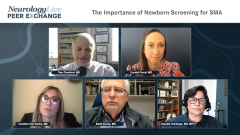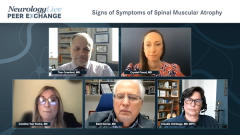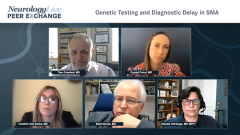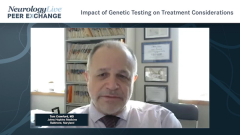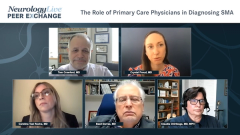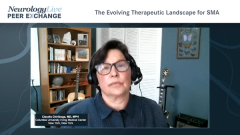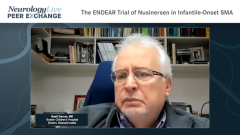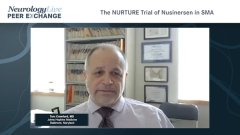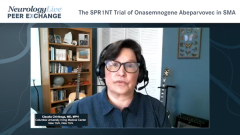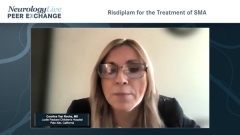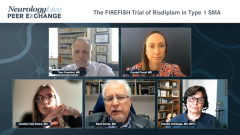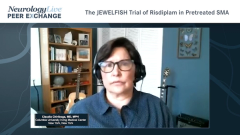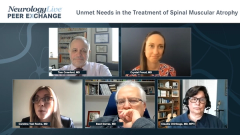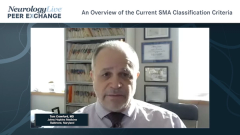
The Evolving Therapeutic Landscape for SMA
Carolina Tesi Rocha, MD examines the recent shift to disease-modifying treatment in SMA, and the panel reviews factors to consider when tailoring therapy to individual patients.
Episodes in this series

Crystal Proud, MD: Let’s shift gears a bit and move into discussing the changing landscape for the treatment of spinal muscular atrophy. I’d like to start out by inviting Carolina to talk with us about how things have changed over time.
Carolina Tesi Rocha, MD: There have been a lot of changes. There are a lot of changes, and we are happy to still be seeing these patients. There has been an expression of this idea for many of us who decided to go into neuromuscular medicine, and we are finally seeing that. There’s no doubt that having a specific therapy for the treatment of spinal muscular atrophy [SMA] has been revolutionary, of course not only for the field of neuromuscular medicine or neurology, if you will, but for the history of medicine. The excitement about getting access to disease-modifying treatment for a condition that has been acute for more than a century is unprecedented.
With that said, even before the approval of these drugs, changes in the standard of care of patients with SMA in preparation for clinical trial readiness were quite significant, and that was already changing the natural history if you look at different papers that talk about this. The clinical outcomes and quality of life of the patients were affected by this change in the way we were caring for patients, not just with these fancy treatments, but with specific support in terms of nutrition and respiratory care and orthopedics. This emphasizes the importance of the continuation of care, the standards, and monitoring of these treated patients now, even when the medication is provided in presymptomatic stages.
I would say that, at least to me, this is just the beginning. We are still learning. Every time I see a patient, even if they got treatment at the same time as another, they are all different. I’m learning about the long-term effects of these new drugs, and I’m willing to know more with what the future brings. Independent of that, the studies continue to demonstrate that, as Tom and everybody else was saying, we have better efficacy in patients with the shortest disease duration, of course, and the difference between patients treated pre -symptomatically and post-symptomatically is dramatic.
However, with these exciting changes come new challenges, and we were touching base on those in the prior conversation. With the early identification of patients with neonatal pre-screening programs, how has that changed your practice? How many more providers do you have to bring on to take care of these kids? They all have phenotypes of their own, and there are differences in the degree of response of each individual and changes in the overall management, and monitoring potential adverse effects of the new drugs: these are new things that we have to take into consideration when seeing these patients these days. These changes are seen not only with regard to medical care, but also for public health policymakers with the high cost of these innovative treatments. There is psychological and socioeconomic burden, and there are also the ethical considerations involving patients and their family. We were just talking about what to do when a patient with SMA type 0 is in the NICU [neonatal intensive care unit], and the family wants to treat. How do you set up those expectations? How do you manage the socioeconomic burden that will come when you to continue to treat someone with that characteristic? Again, there are a lot of questions and not a lot of answers, but these are exciting times.
Crystal Proud, MD: Absolutely. We now have 3 FDA-approved therapies, including nusinersen, onasemnogene abeparvovec, and risdiplam, so I’d like to ask Claudia to start. How do you tailor therapy for your individual patients, and which factors do you take into consideration when you’re discussing opportunities for intervention?
Claudia A. Chiriboga-Klein, MD, PhD: Absolutely. It varies according to age and whether they’re presymptomatic. For patients under 2 months of age, which would be the infants identified with newborn screening or very early presentation, we only have 2 agents: nusinersen and onasemnogene abeparvovec. For brevity, I’ll call these gene transfer therapy. With regard to that, parental preference plays a role, but up to a degree. Many patients’ families prefer a single agent. Others are afraid of the biological consequences of gene transfer therapy, so all of those factors go into account. There is then the issue of whether there are any factors that are contraindications, such as AAV9 titers, troponin, for onasemnogene. It’s important to treat early, and if there’s anything that’s going to delay treatment in that young group, it’s important to start with what you can, which would oftentimes be nusinersen, for example, and you bridge until the time when whatever the contraindications were pass, so that you can try with another agent when the patient is older.
For example, if the family wants to pursue gene transfer therapy, which can be obtained, you’ll have a bit of time if you’ve loaded to obtain that without any delay of treatment to the infant. I then make a distinction after 2 months of age with regard to whether it’s early presentation, like in the clinical trial age, or whether it’s very late. For example, if it’s a young child with type 1 SMA, and especially those with type 2 SMA, because they’re doing well in infancy, any of the agents after 3 months of age would be appropriate. That often depends on what the family would like to do.
I make a distinction in patients of older ages. For example, with a patient with late type 1 SMA who is on respiratory support 24/7, I would not think that the gene transfer therapy would be the best approach because the response, at least from my experience, is not as great as it is earlier. There is a lot of risk involved for little benefit because a lot of the risks of onasemnogene abeparvovec are weight-based, and the older child may have higher risks. The Europeans have run into that, especially because their cutoff is 20 kg, not 2 years of age. When you’re dealing with later-onset SMA, you’ll oftentimes have to deal with access issues with their scoliosis and hardware, and that might make it difficult to administer medication.
After 2 years, there are only 2 agents: risdiplan or nusinersen. If a patient is on a medication, and it’s working for them, then there’s no reason to switch. Those are the factors that come into play.
The important thing is to note that you can’t compare efficacy because they are very different. The ages, the severity, the duration of follow-up, and even the measurements are different, as is the degree of scoliosis, so you can’t compare them head-to-head to make decisions based on that. Those are the guidelines that I use with parents, and we try to honor their requests as best as possible.
Crystal Proud, MD: It seems as though many of our parents come to the clinic with at least some degree of Googling and some reading that’s been done, and many come already with fantastic questions and at least a concept of what they think they’d like to talk with you about. This has been my experience, but is this the experience you have had as well?
Claudia A. Chiriboga-Klein, MD, PhD: Absolutely, they already come with a mindset. They are sometimes already fixated on gene therapy in the early ages, and we have them try something else until you can actually obtain and treat them safely with the medication. They sometimes prefer to wait when it’s not to the best advantage. As everyone said, there’s a loss of motor neurons. Just to preface what everyone’s been saying about the loss of motor neurons, a lot of that 50% loss is based on early infancy when there’s limited motor mobility, and there’s little ability to determine that you’re not going to have X or Y function down the line. I don’t think we can say that, if you’re going to have type 3 SMA, whether that’s the same with regard to early identification and motor loss. Yes, they do have a mindset, and many of them are already opposed to invasive treatments or prefer a specific type of treatment.
Basil Darras, MD: Even in type 3 SMA, when they become symptomatic and come into the clinic with weakness, diminished muscle tone, areflexia…at that point, they have lost a substantial number of motor neurons. This information has been derived from the ALS [amyotrophic lateral sclerosis] studies. The loss ranges between 30% and 70%. Again, I feel that even losing 23% of motor neurons can be catastrophic, and you may get worse as you get older.
Claudia A. Chiriboga-Klein, MD, PhD: Yes, Basil, I agree with that, but those are not patients who are being followed. We know that there are delays in identification and treatment and that you have to have a certain amount of loss for people even to identify that you have the diagnosis. I don’t think we can say that if you are following them diligently and treat them the first moment their 6-minute walk test slows or if their reflex is lost with nothing else. I’ve had good response even with onasemnogene abeparvovec when you identify them early, such that you can prevent that kind of a loss.
Basil Darras, MD: Of course. The medications act on the surviving motor neurons, and you are going to have efficacy if you start early. Absolutely.
Thomas Crawford, MD: One of the cool things about having 3 new therapies is that it hasn’t resolved the fact that there are controversies and that there are opinions. Of course, my opinions are obviously the best, and if I didn’t think so, I would change them by the way. The quandary is that we all value our own experience. We all value the latest case or the latest concern that arose from things. It’s wise for us to all know of the limitations and the biases that come into how we make these decisions.
The real quandary is that safety exists in one dimension and efficacy exists in a different dimension, and they don’t interact. If you are safe, everybody agrees that it’s wonderful if the drug works. If it was not safe, then the drug was awful, yet it was a crapshoot whether you’re going to do one or the other. These are real quandaries that come when we try to decide. There are guideposts. There are things that are a wonderful system of double-blinded placebo-controlled; the modern era of clinical investigation of drugs has led to a lot of information, which is fantastic, but they’re not overlapping.
The first person in the field studies it and gets the advantage of having the indication. The next people in line are able to tailor their experiments to pick off the sweet spot to be able to show the benefits, and show that they’re better as a consequence because they’ve been able to do that. It’s important to be mindful to know that everybody tries to show that their drug works, and they try to design the trials in a way that shows efficacy. That’s appropriate; they should do that. But it means that we as clinicians are stuck trying to figure out where the crevices are in between and how we weigh the benefit and burden of limited sensitivity data, concerns about the efficacy, preclinical data that suggest that the drug works better when they’re in this group vs that group, and all kinds of things that we have to think about quite carefully.
Crystal Proud, MD: Thank you for watching this NeurologyLive® Peer Exchange. If you enjoyed the content, please subscribe to our e-newsletters to receive upcoming Peer Exchanges and other great content right in your inbox.
Transcript Edited for Clarity
Newsletter
Keep your finger on the pulse of neurology—subscribe to NeurologyLive for expert interviews, new data, and breakthrough treatment updates.

